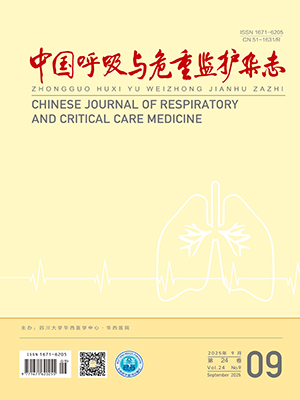| 1. |
Nwogu CE, D'Cunha J, Pang H, et al. VATS lobectomy has better perioperative outcomes than open lobectomy: CALGB 31001, an ancillary analysis of CALGB 140202 (Alliance). Ann Thorac Surg, 2015, 99(2): 399-405.
|
| 2. |
Cardinale L, Priola AM, Priola SM, et al. Radiological contribution to the diagnosis of early postoperative complications after lung resection for primary tumor: a revisional study. J Thorac Dis, 2016, 8(8): E643-E652.
|
| 3. |
Licker M, de Perrot M, Spiliopoulos A, et al. Risk factors for acute lung injury after thoracic surgery for lung cancer. Anesth Analg, 2003, 97(6): 1558-1565.
|
| 4. |
de Prost N, Pham T, Carteaux G, et al. Etiologies, diagnostic work-up and outcomes of acute respiratory distress syndrome with no common risk factor: a prospective multicenter study. Ann Intensive Care, 2017, 7(1): 69.
|
| 5. |
Russ M, Kronfeldt S, Boemke W, et al. Lavage-induced surfactant depletion in pigs as a model of the acute respiratory distress syndrome (ARDS) . J Vis Exp, 2016, (115). doi: 10.3791/53610.
|
| 6. |
Gajic O, Dabbagh O, Park P K, et al. Early identification of patients at risk of acute lung injury: evaluation of lung injury prediction score in a multi center cohort study. Am J Respir Crit Care Med, 2011, 183(4): 462-470.
|
| 7. |
乔良, 刘志. 按柏林新标准分析急诊脓毒症患者发生急性呼吸窘迫综合征的危险因素. 中华危重病急救医学, 2015, 27(7): 558-562.
|
| 8. |
Kor DJ, Warner DO, Alsara A, et al. Derivation and diagnostic accuracy of the surgical lung injury prediction model. Anesthesiology, 2011, 115(1): 117-128.
|
| 9. |
奚高原, 王志涛, 董铁立. 右美托咪定对大鼠单肺通气后肺损伤中细胞凋亡及 CHOP 的影响. 临床麻醉学杂志, 2015, 31(2): 184-188.
|
| 10. |
Seethala RR, Hou PC, Aisiku IP, et al. Early risk factors and the role of fluid administration in developing acute respiratory distress syndrome in septic patients. Ann Intensive Care , 2017, 7(1): 11.
|
| 11. |
苏瑞雪, 李玉兰, 潘道刚, 等.单肺通气中肺损伤与肺复张策略.临床肺科杂志, 2015, 20(10): 1876-1878.
|
| 12. |
Kor DJ, Lingineni RK, Gajic O, et al. Predicting risk of postoperative lung injury in high-risk surgical patients: a multicenter cohort study. Anesthesiology, 2014, 120(5): 1168-1181.
|
| 13. |
钟宝琳, 黄桂明, 李以平, 等.术后急性肺损伤的危险因素分析. 临床麻醉学杂志, 2015, 31(9): 888-889.
|
| 14. |
夏炎火, 童秋玲, 林锡芳, 等. 肺损伤预测评分在 ALI/ARDS 早期诊断中的应用. 医学研究杂志, 2013, 42(02): 120-123.
|
| 15. |
Dada L, Gonzalez AR, Urich D, et al. Alcohol worsens acute lung injury by inhibiting alveolar sodium transport through the adenosine A1 receptor. PLoS One, 2012, 7(1): e30448.
|
| 16. |
Fini MA, Gaydos J, McNally A, et al. Alcohol Abuse is Associated with Enhanced Pulmonary and Systemic Xanthine Oxidoreductase Activity. Am J Physiol Lung Cell Mol Physiol, 2017, 313(6): L1047-L1057.
|
| 17. |
Trillo-Alvarez C, Cartin-Ceba R, Kor DJ, et al. Acute lung injury prediction score: derivation and validation in a population-based sample. Eur Respir J , 2011, 37(3): 604-609.
|




